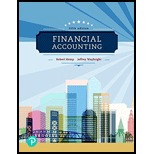
Financial Accounting (5th Edition) (What's New in Accounting)
5th Edition
ISBN: 9780134727790
Author: Robert Kemp, Jeffrey Waybright
Publisher: PEARSON
expand_more
expand_more
format_list_bulleted
Textbook Question
Chapter 7, Problem 40BE
Quick ratio and
Consider the following data:
| COMPANY | A | B | C | D |
| Cash.......................................... | $ 9,200 | $ 6,000 | $2,000 | $10,600 |
| Short-term Investments............ | 7,200 | 2,400 | 1,400 | 5,500 |
| Net Current Receivables............ | 12,100 | 10,800 | 4,900 | 13,500 |
| Total Current Assets.................. | 32,500 | 22,600 | 8,700 | 31,500 |
| Current Liabilities...................... | 16,000 | 8,800 | 4,500 | 36,000 |
Requirements
- 1. Calculate the quick assets and the quick ratio for each company.
- 2. Calculate the current ratio for each company.
- 3. Which company should be concerned about its liquidity?
Expert Solution & Answer
Want to see the full answer?
Check out a sample textbook solution
Students have asked these similar questions
How much gain must he recognize on this conversion?
No wrong answer
Accounting problem with solution
Chapter 7 Solutions
Financial Accounting (5th Edition) (What's New in Accounting)
Ch. 7.A - Prob. 1SECh. 7.A - Prob. 2SECh. 7.A - Prob. 3AECh. 7.A - Prob. 4AECh. 7.A - Prob. 5BECh. 7.A - Prob. 6BECh. 7.A - Prob. 7APCh. 7.A - Prob. 8BPCh. 7 - Which duties should be segregated in the...Ch. 7 - Prob. 2DQ
Ch. 7 - Prob. 3DQCh. 7 - Why does the allowance method of accounting for...Ch. 7 - Prob. 5DQCh. 7 - Prob. 6DQCh. 7 - Prob. 7DQCh. 7 - How would the net realizable value of Accounts...Ch. 7 - Prob. 9DQCh. 7 - Prob. 10DQCh. 7 - Prob. 1SCCh. 7 - Prob. 2SCCh. 7 - Prob. 3SCCh. 7 - Prob. 4SCCh. 7 - Prob. 5SCCh. 7 - Prob. 6SCCh. 7 - Prob. 7SCCh. 7 - Prob. 8SCCh. 7 - Prob. 9SCCh. 7 - Prob. 10SCCh. 7 - Prob. 11SCCh. 7 - Prob. 12SCCh. 7 - Prob. 1SECh. 7 - Prob. 2SECh. 7 - Prob. 3SECh. 7 - Prob. 4SECh. 7 - Prob. 5SECh. 7 - Prob. 6SECh. 7 - Prob. 7SECh. 7 - Prob. 8SECh. 7 - Prob. 9SECh. 7 - Prob. 10SECh. 7 - Prob. 11SECh. 7 - Prob. 12SECh. 7 - Prob. 13SECh. 7 - Prob. 14SECh. 7 - Prob. 15SECh. 7 - Quick ratio (Learning Objective 7) 510 min....Ch. 7 - Prob. 17SECh. 7 - Prob. 18AECh. 7 - Prob. 19AECh. 7 - Prob. 20AECh. 7 - Prob. 21AECh. 7 - Prob. 22AECh. 7 - Prob. 23AECh. 7 - Prob. 24AECh. 7 - Prob. 25AECh. 7 - Prob. 26AECh. 7 - Prob. 27AECh. 7 - Quick ratio and current ratio (Learning Objective...Ch. 7 - Prob. 29AECh. 7 - Prob. 30BECh. 7 - Prob. 31BECh. 7 - Prob. 32BECh. 7 - Prob. 33BECh. 7 - Prob. 34BECh. 7 - Aging of accounts receivable allowance method...Ch. 7 - Prob. 36BECh. 7 - Prob. 37BECh. 7 - Prob. 38BECh. 7 - Prob. 39BECh. 7 - Quick ratio and current ratio (Learning Objective...Ch. 7 - Prob. 41BECh. 7 - Prob. 42APCh. 7 - Prob. 43APCh. 7 - Prob. 44APCh. 7 - Prob. 45APCh. 7 - Prob. 46APCh. 7 - Accounting for notes receivable (Learning...Ch. 7 - Prob. 48APCh. 7 - Prob. 49BPCh. 7 - Prob. 50BPCh. 7 - Prob. 51BPCh. 7 - Prob. 52BPCh. 7 - Prob. 53BPCh. 7 - Prob. 54BPCh. 7 - Prob. 55BPCh. 7 - Continuing Exercise In this exercise, we continue...Ch. 7 - Prob. 1CPCh. 7 - Prob. 1CFSAPCh. 7 - Prob. 1EIACh. 7 - Prob. 2EIACh. 7 - Financial Analysis Purpose: To help familiarize...Ch. 7 - Industry Analysis Purpose: To help you understand...Ch. 7 - Prob. 1SBACh. 7 - Prob. 1WC
Additional Business Textbook Solutions
Find more solutions based on key concepts
Opportunity cost of capital Which of the following statements are true? The opportunity cost of capital:
Equals...
PRIN.OF CORPORATE FINANCE
Is reporting an investment at its cost considered relevant? Explain
Intermediate Accounting (2nd Edition)
To what does the lifetime value of the customer refer, and how is it calculated?
MARKETING:REAL PEOPLE,REAL CHOICES
Explain how to derive a total expenditures (TE) curve.
Macroeconomics
BE5-6 Explain where each of these items would appear on a multiple-step income statement: gain on disposal of p...
Financial Accounting: Tools for Business Decision Making, 8th Edition
Consider the sales data for Computer Success given in Problem 7. Use a 3-month weighted moving average to forec...
Operations Management: Processes and Supply Chains (12th Edition) (What's New in Operations Management)
Knowledge Booster
Learn more about
Need a deep-dive on the concept behind this application? Look no further. Learn more about this topic, accounting and related others by exploring similar questions and additional content below.Similar questions
arrow_back_ios
SEE MORE QUESTIONS
arrow_forward_ios
Recommended textbooks for you

 AccountingAccountingISBN:9781337272094Author:WARREN, Carl S., Reeve, James M., Duchac, Jonathan E.Publisher:Cengage Learning,
AccountingAccountingISBN:9781337272094Author:WARREN, Carl S., Reeve, James M., Duchac, Jonathan E.Publisher:Cengage Learning, Accounting Information SystemsAccountingISBN:9781337619202Author:Hall, James A.Publisher:Cengage Learning,
Accounting Information SystemsAccountingISBN:9781337619202Author:Hall, James A.Publisher:Cengage Learning, Horngren's Cost Accounting: A Managerial Emphasis...AccountingISBN:9780134475585Author:Srikant M. Datar, Madhav V. RajanPublisher:PEARSON
Horngren's Cost Accounting: A Managerial Emphasis...AccountingISBN:9780134475585Author:Srikant M. Datar, Madhav V. RajanPublisher:PEARSON Intermediate AccountingAccountingISBN:9781259722660Author:J. David Spiceland, Mark W. Nelson, Wayne M ThomasPublisher:McGraw-Hill Education
Intermediate AccountingAccountingISBN:9781259722660Author:J. David Spiceland, Mark W. Nelson, Wayne M ThomasPublisher:McGraw-Hill Education Financial and Managerial AccountingAccountingISBN:9781259726705Author:John J Wild, Ken W. Shaw, Barbara Chiappetta Fundamental Accounting PrinciplesPublisher:McGraw-Hill Education
Financial and Managerial AccountingAccountingISBN:9781259726705Author:John J Wild, Ken W. Shaw, Barbara Chiappetta Fundamental Accounting PrinciplesPublisher:McGraw-Hill Education


Accounting
Accounting
ISBN:9781337272094
Author:WARREN, Carl S., Reeve, James M., Duchac, Jonathan E.
Publisher:Cengage Learning,

Accounting Information Systems
Accounting
ISBN:9781337619202
Author:Hall, James A.
Publisher:Cengage Learning,

Horngren's Cost Accounting: A Managerial Emphasis...
Accounting
ISBN:9780134475585
Author:Srikant M. Datar, Madhav V. Rajan
Publisher:PEARSON

Intermediate Accounting
Accounting
ISBN:9781259722660
Author:J. David Spiceland, Mark W. Nelson, Wayne M Thomas
Publisher:McGraw-Hill Education

Financial and Managerial Accounting
Accounting
ISBN:9781259726705
Author:John J Wild, Ken W. Shaw, Barbara Chiappetta Fundamental Accounting Principles
Publisher:McGraw-Hill Education
Economic Value Added EVA - ACCA APM Revision Lecture; Author: OpenTuition;https://www.youtube.com/watch?v=_3hpcMFHPIU;License: Standard Youtube License